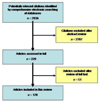A systematic review of applying patient satisfaction outcomes in plastic surgery
- PMID: 20517109
- PMCID: PMC4389690
- DOI: 10.1097/PRS.0b013e3181d51276
A systematic review of applying patient satisfaction outcomes in plastic surgery
Abstract
Background: The authors performed a systematic review of patient satisfaction studies in the plastic surgery literature. The specific aim was to evaluate the status of satisfaction research that has been undertaken to date and to identify areas for improvement.
Methods: Four medical databases were searched using satisfaction and plastic surgery-related search terms. Quality of selected articles was assessed by two trained reviewers.
Results: Of the total of 2936 articles gleaned by the search, 178 were included in the final review. The majority of the articles (58 percent) in our review examined patient satisfaction in breast surgery populations. In addition, 53 percent of the articles were limited in scope and only measured features of care in one or two domains of satisfaction. Finally, the majority of the studies (68 percent) were based solely on the use of ad hoc satisfaction measurement instruments that did not undergo formal development.
Conclusions: Given the important policy implications of patient satisfaction data within plastic surgery, we found a need to further refine research in this area. The scarcity of satisfaction research in the craniofacial, hand, and other reconstructive specialties, the narrow scope of satisfaction measurement, and the use of unvalidated instruments are current barriers preventing plastic surgery patient satisfaction studies from producing meaningful results.
Figures
References
-
- Donabedian A. Evaluating the quality of medical care. Milbank Mem Fund Q. 1966;44(3):166–206. - PubMed
-
- Ware JEJ. How to Survey Patient Satisfaction. Drug Intelligence and Clinical Pharmacy. 1981;15:892–899. - PubMed
-
- Linder-Pelz S. Toward a Theory of Patient satisfaction. Soc Sci Med. 1982;16:577–582. - PubMed
-
- Ware JEJ. Defining and Measuring Patient Satisfaction with Medical Care. Evaluation and Program Planning. 1983;6:247–263. - PubMed
-
- Ware JEJ, Davies-Avery A, Steward A. The measurement and meaning of patient satisfaction. Health Med Care Serv Rev. 1978;1:3–15. - PubMed
Publication types
MeSH terms
Grants and funding
LinkOut - more resources
Full Text Sources




